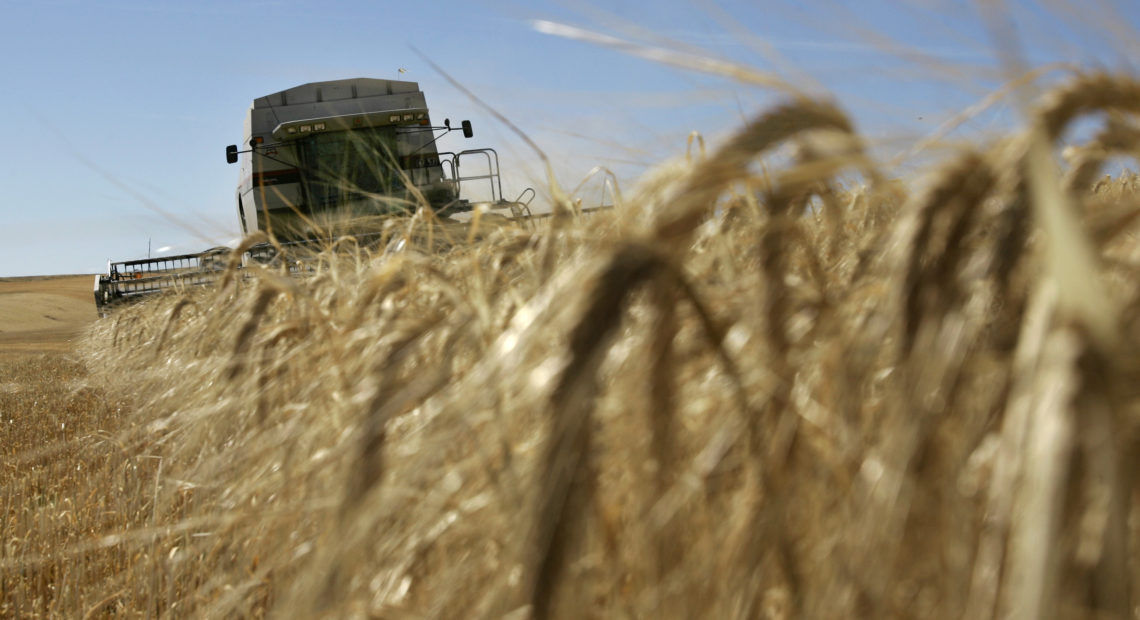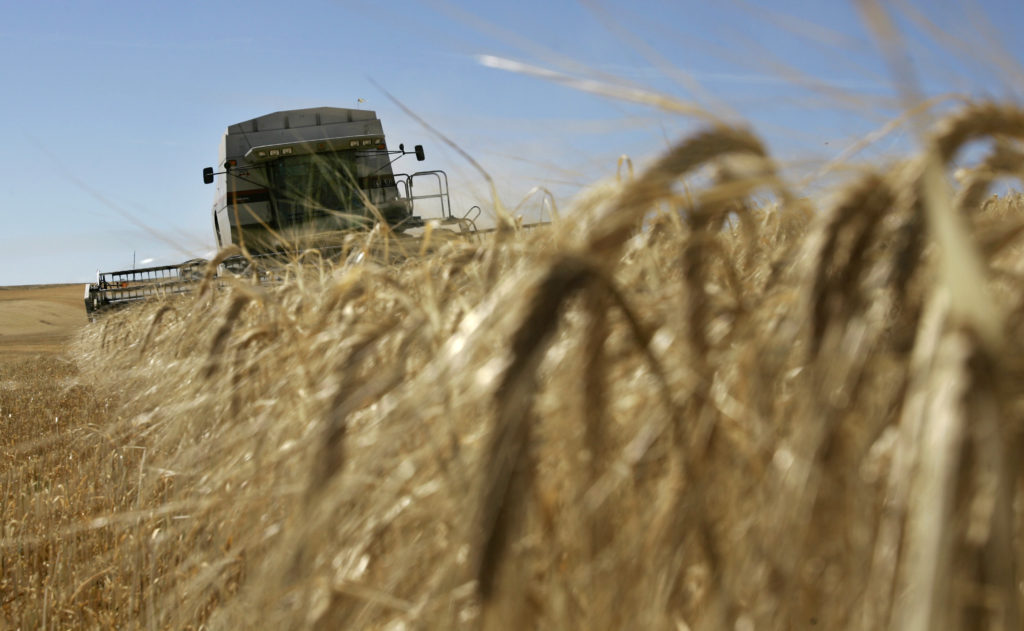
What Is The Toll Of Trade Wars On U.S. Agriculture?
BY MENZIE CHINN & BILL PLUMLEY / PBS NewsHour
NOTE: This analysis is being published in collaboration with EconoFact, a nonpartisan economic publication. Read the original article here.
U.S. agriculture has been caught in the tit-for-tat of the trade wars, most notably with China.
American agricultural exports to China fell from $15.8 billion in 2017 to $5.9 billion in 2018, according to the U.S. International Trade Administration, and exports have remained depressed in 2019.
The recently signed Phase 1 U.S.-China deal promises some relief.
Details remain unclear, but the United States government’s interpretation of this deal is that China will purchase $40 billion of agricultural goods in 2020. Some analysts have questioned how realistic those estimates are, given that the highest level of farm products the United States has ever exported to China was $26 billion in 2012, although one Chinese agricultural consultancy company says this can be achieved.

A combine harvests barley Friday, Aug. 24, 2007, near Moscow, Idaho. CREDIT: Ted S. Warren/AP
Furthermore, there is a question as to how much of this would be above and beyond what China would have otherwise purchased, particularly given the increased demand for imported pork due to African Swine Fever that has swept through China. Moreover, some share of the figure will be due to recategorization of trade going through Hong Kong.
However, there is no doubt the deal is likely to offer some tariff relief through waivers for imports of U.S. agricultural goods. A larger question is whether the disruptions to the agriculture sector induced by trade tensions over the past two years will have longer-lasting effects.
Retaliation by China, Canada, Mexico, Turkey and members of the European Union to tariffs imposed by the Trump administration have taken a bite out of U.S. agricultural incomes. Tariffs on imports of steel and aluminum in the United States have also raised costs for machines, equipment and structures used by the agriculture sector.
Agriculture incomes would have shown no growth in 2019 but for massive and unprecedented federal assistance.
Even with this assistance, however, the agriculture sector shows signs of stress, with a rise in debt, a decrease in solvency and an increased number of bankruptcies.
The facts
- Many countries imposed retaliatory tariffs on United States agricultural exports in response to the Trump administration’s tariffs on their exports. Exports have been an important component of farm income, especially since 2005 (see here). In 2018, tariffs were imposed by China on almost all U.S. agricultural products; by Canada on prepared meats, fruits and vegetables, coffee and whiskey; by Mexico on pork, prepared fruits and vegetables, cheese and vegetables; by the European Union (EU) on prepared vegetables and legumes, grains, fruit juice, peanut butter and whiskey; and by Turkey on tree nuts, rice, some prepared foods, whiskey and tobacco (see here). Several of these tariffs have since been lifted as a result of ongoing negotiations. Canada and Mexico lifted retaliatory tariffs on the U.S. to clear the way for the ratification of the U.S.-Mexico-Canada Free Trade Agreement in May of 2019, as the U.S. also lifted its tariffs on steel and aluminum from Mexico and Canada.
- The impact of retaliatory tariffs was particularly significant for agricultural trade with China. U.S. exports of agricultural products to China decreased by 63% between 2017 and 2018, from $15.8 billion to $5.9 billion. The effects of this were concentrated in Washington, Louisiana, Texas, California, and Oregon, which together accounted for nearly 80% of 2018’s exports, according to our calculations based on data from the U.S. International Trade Administration. All but Oregon saw double-digit percent declines in the value of agricultural exports to China, with a decrease of 82.5% in Louisiana and of 57.2% in Washington, which was the biggest agricultural exporter to China and had a decline from $4.4 billion in 2017 to $1.9 billion in 2018. Despite the retaliatory tariffs, overall U.S. agricultural exports rose slightly in 2018 to $140 billion from $138 billion in 2017, partly due to higher imports during the months leading up to the retaliatory tariffs and increased exports to other non-retaliating countries, according to the Congressional Research Service.
- “Trade wars” have also had other indirect effects on United States agriculture costs and revenues. The Trump administration imposed tariffs on a range of goods that affect the costs of production for United States agriculture, most notably steel and aluminum imports. This has raised farm production costs. IHS Markit reportis that higher steel prices could raise manufacturing costs of farming equipment by an average of 6%. The strength of the dollar, which is associated with expansionary fiscal policy in the U.S., slower economic growth abroad and increased uncertainty in trade policy, has raised the price of agricultural exports in terms of other currencies, which has also cut into the demand for these goods and put downward pressure on agricultural prices. Farmers reported facing higher equipment costs and being squeezed between lower commodity prices and rising input costs to the Federal Reserve’s “Beige Book” survey in March of 2019 (see here).
- The agriculture sector had record levels of debt in 2019 and the highest number of bankruptcies since 2011. In October, the United States Department of Agriculture (USDA) projected that farm debt in 2019 would be a record high $416 billion, with $257 billion in real estate debt and $159 billion in non-real estate debt. Adjusting for inflation, the value of debt increased 1.5% between 2018 and 2019. The USDA predicts solvency measures that reflect the ability to satisfy debt obligations are expected to decrease in 2019 and be at the weakest levels since 2009. Court records show that the 580 Chapter 12 farm bankruptcies in the year ending in September 2019 were up 24 percent from the prior year and were at the highest annual level since 2011.
- The Federal government has provided unprecedented levels of financial support to farmers in 2019; but for this, there would have been no growth in real farm income between 2018 and 2019 (see chart). The figure shows the change in net farm income (revenues minus costs of inputs, wages and salaries) by the agriculture sector over the past nine years. The blue bars represent income net of both payments from the government and taxes and fees paid to the government, and the maroon bars represent net government payments. The figure shows large reductions in income in 2011 – 2012, 2013 – 2014 and 2015 – 2016. These were years when agricultural prices were falling; for example, between the Spring of 2011 and the end of 2016 the prices of soybeans, corn and wheat fell by 25%, 52% and 60%, respectively. But price changes between the beginning of 2018 and the end of 2019 have been more stable, with a decline of 7% for soybeans, an increase of 6% for corn and no change for wheat. Despite this price stability, the only source of increase in agriculture net income between 2018 and 2019 is through government support. This recent support has come from a novel source; the U.S. Department of Agriculture directed the Commodity Credit Corporation to borrow $28 billion (nearly the limit of its $30 billion limit) to provide relief to farmers burdened by foreign tariffs in 2018 and 2019 through cash payments to farms (the Market Facilitation Program), purchases of surplus products (the Food Purchase and Distribution Program) and funding to support new export markets (the Trade Promotion Program). The USDA Economic Research Service estimates that 40% of national farm income in 2019 will have come from federal programs including disaster assistance and insurance, raising concerns about the farm industry’s dependency on government aid. Federal government direct farm support payments are estimated to have increased over 60 percent (in inflation-adjusted terms) between 2018 and 2019, to $22.4 billion, more than triple the percentage increase between any other two years in the past decade. The biggest source of this is the Market Facilitation Program that increased by about 175 percent to $14.3 billion.
Copyright 2020 PBS NewsHour. To see more, visit npr.org















